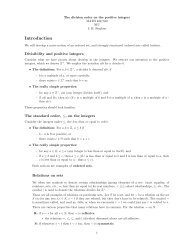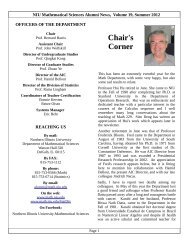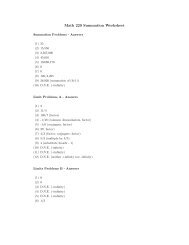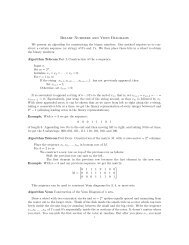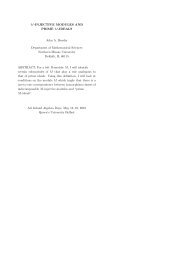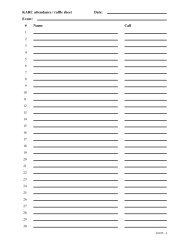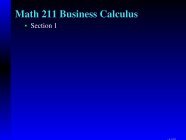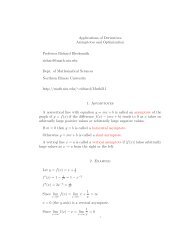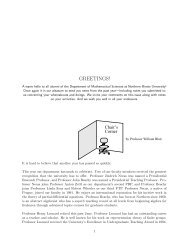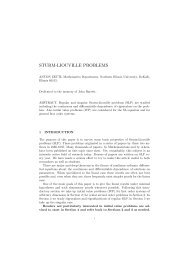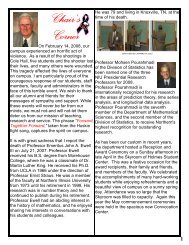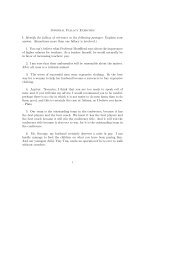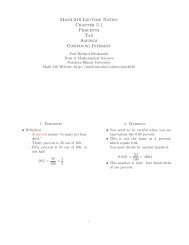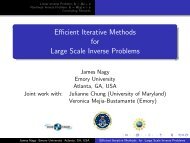MODULE 2 Logic is the beginning of wisdom, not the end. â Mr ...
MODULE 2 Logic is the beginning of wisdom, not the end. â Mr ...
MODULE 2 Logic is the beginning of wisdom, not the end. â Mr ...
You also want an ePaper? Increase the reach of your titles
YUMPU automatically turns print PDFs into web optimized ePapers that Google loves.
<strong>MODULE</strong> 2<br />
<strong>Logic</strong><br />
<strong>Logic</strong> <strong>is</strong> <strong>the</strong> <strong>beginning</strong> <strong>of</strong> w<strong>is</strong>dom, <strong>not</strong> <strong>the</strong> <strong>end</strong>. – <strong>Mr</strong>. Spock<br />
Five habits <strong>of</strong> a ma<strong>the</strong>matician are <strong>the</strong> ability to (1) develop intuition, (2) gain experience,<br />
(3) make connections, (4) think abstractly, and (5) look for structure. At <strong>the</strong> very<br />
foundation <strong>of</strong> all <strong>the</strong>se charactericstics <strong>of</strong> a ma<strong>the</strong>matician <strong>is</strong> logic.<br />
Elementary logic provides <strong>the</strong> basic rules for constructing sound, compelling arguments.<br />
The building blocks <strong>of</strong> logical arguments are logical statements. A logical statement <strong>is</strong><br />
a declarative sentence which conveys factual information. If <strong>the</strong> information <strong>is</strong> correct <strong>the</strong>n<br />
we say <strong>the</strong> statement <strong>is</strong> true; and if <strong>the</strong> information <strong>is</strong> incorrect, <strong>the</strong>n we say <strong>the</strong> statement<br />
<strong>is</strong> false.<br />
In th<strong>is</strong> module we will study how logical statements are combined and used to make<br />
correct arguments.<br />
1. Statements and negations<br />
All logical statements are formed by combining simple statements.<br />
A simple statement <strong>is</strong> a logical statement carrying one piece <strong>of</strong> information.<br />
Example 2.1. Each <strong>of</strong> <strong>the</strong> following <strong>is</strong> a simple statement:<br />
(1) The United States Post Office delivers mail.<br />
(2) Par<strong>is</strong> <strong>is</strong> <strong>the</strong> capital <strong>of</strong> Tanzania.<br />
(3) The polynomial x 2 − 1 factors as (x − 1)(x + 1).<br />
Statements 1 and 3 are true. Statement 2 <strong>is</strong> false.<br />
Not all short sentences are simple statements<br />
37
38 2. LOGIC<br />
Example 2.2.<br />
(1) Close <strong>the</strong> window. Th<strong>is</strong> <strong>is</strong> a command. It does <strong>not</strong> convey information and <strong>is</strong> <strong>not</strong><br />
a logical statement.<br />
(2) The United States Congress <strong>is</strong> doing an excellent job. Th<strong>is</strong> <strong>is</strong> a statement <strong>of</strong><br />
opinion, <strong>not</strong> a logical statement.<br />
The negation <strong>of</strong> a logical statement <strong>is</strong> a new logical statement which says <strong>the</strong> opposite<br />
<strong>of</strong> <strong>the</strong> original statement. The statement<br />
<strong>not</strong> p<br />
<strong>is</strong> true exactly when <strong>the</strong> original statement p <strong>is</strong> false. To negate a logical statement means<br />
to find <strong>the</strong> statement’s negation. Various ways to form <strong>the</strong> negation <strong>of</strong> a statement are<br />
d<strong>is</strong>cussed in <strong>the</strong> next example.<br />
Example 2.3. We could negate <strong>the</strong> statement<br />
<strong>the</strong> sky <strong>is</strong> blue<br />
by forming <strong>the</strong> statement<br />
it <strong>is</strong> <strong>not</strong> <strong>the</strong> case that <strong>the</strong> sky <strong>is</strong> blue.<br />
We can negate any statement in th<strong>is</strong> way, but such constructions are clumsy and sometimes<br />
unclear. The negation<br />
<strong>the</strong> sky <strong>is</strong> <strong>not</strong> blue<br />
<strong>is</strong> much clearer.<br />
A statement containing a negative can <strong>of</strong>ten be negated by removing <strong>the</strong> negative.<br />
Example 2.4.<br />
(1) The negation <strong>of</strong><br />
loitering <strong>is</strong> <strong>not</strong> permitted here<br />
<strong>is</strong><br />
loitering <strong>is</strong> permitted here.<br />
(2) The negation <strong>of</strong>
1. STATEMENTS AND NEGATIONS 39<br />
<strong>is</strong><br />
e-mail <strong>is</strong> unreliable<br />
e-mail <strong>is</strong> reliable.<br />
When a logical statement <strong>is</strong> used to say something about a collection <strong>of</strong> objects, <strong>the</strong><br />
statement must be quantified—that <strong>is</strong>, we must specify which objects in <strong>the</strong> collection <strong>the</strong><br />
statement applies to. The basic d<strong>is</strong>tinctions between applications are reflected in <strong>the</strong> words<br />
all and some.<br />
If a logical statement applies to all objects in a collection, <strong>the</strong>n it <strong>is</strong> called a universally<br />
quantified statement. For example,<br />
(1) Every McDonald’s serves french fries.<br />
(2) All math majors study calculus.<br />
A logical statement which applies to some objects in a collection <strong>is</strong> called an ex<strong>is</strong>tentially<br />
quantified statement. For example,<br />
(1) Some people att<strong>end</strong> college.<br />
(2) There are people who believe in UFO’s.<br />
As illustrated above, an ex<strong>is</strong>tentially quantified statement asserts that an object <strong>of</strong> a particular<br />
nature ex<strong>is</strong>ts.<br />
We can contrast universally quantified statements and ex<strong>is</strong>tentially quantified statements<br />
in <strong>the</strong> following way.<br />
• Universal quantification—If every object in <strong>the</strong> collection fits <strong>the</strong> description,<br />
<strong>the</strong>n <strong>the</strong> universally qualified statement <strong>is</strong> true.<br />
• Ex<strong>is</strong>tential quantification—If <strong>the</strong> ex<strong>is</strong>tentially quantified statement accurately<br />
describes at least one object in <strong>the</strong> collection, <strong>the</strong>n it <strong>is</strong> true.<br />
Example 2.5.<br />
(1) Some people are female. Th<strong>is</strong> ex<strong>is</strong>tentially quantified statement applies to <strong>the</strong><br />
collection <strong>of</strong> people, and states <strong>the</strong> ex<strong>is</strong>tence <strong>of</strong> a person with <strong>the</strong> property <strong>of</strong><br />
being female. It <strong>is</strong> clearly a true statement.
40 2. LOGIC<br />
(2) All people are female. Th<strong>is</strong> universally quantified statement applied to <strong>the</strong> collection<br />
<strong>of</strong> people. Since <strong>the</strong>re are people who are <strong>not</strong> female, it <strong>is</strong> a false statement.<br />
(3) Every whole multiple <strong>of</strong> four <strong>is</strong> even. Th<strong>is</strong> universally quantified statement applies<br />
to <strong>the</strong> collection <strong>of</strong> all whole multiples <strong>of</strong> four. It <strong>is</strong> true since four <strong>is</strong> even, and<br />
every multiple <strong>of</strong> an even number <strong>is</strong> even.<br />
Ma<strong>the</strong>matical knowledge <strong>is</strong> <strong>of</strong>ten expressed with quantified statements:<br />
(1) For all real numbers x and y, x + y = y + x.<br />
(2) All pairs <strong>of</strong> non-parallel lines in <strong>the</strong> plane intersect.<br />
(3) Some numbers can be factored (for example, 6 = 2 × 3, 15 = 3 × 5)<br />
(4) All right triangles obey <strong>the</strong> Pythagorean Theorem<br />
a 2 + b 2 = c 2<br />
C<br />
❍<br />
b ❍❍❍❍ a<br />
✁ ✁✁✁❍ ❍<br />
A c B<br />
The negation <strong>of</strong> a for all statement <strong>is</strong> a some statement.<br />
<strong>is</strong><br />
Example 2.6. The negation <strong>of</strong><br />
All birds can fly<br />
Some birds can<strong>not</strong> fly.<br />
The negation <strong>of</strong> a some statement <strong>is</strong> a for all statement.<br />
<strong>is</strong><br />
Example 2.7. The negation <strong>of</strong><br />
There ex<strong>is</strong>ts an honest man<br />
All men are d<strong>is</strong>honest.<br />
Example 2.8. Consider <strong>the</strong> statement<br />
All numbers can be factored.<br />
A universally quantified statement <strong>is</strong> false if it does <strong>not</strong> apply to at least one object in <strong>the</strong><br />
collection. So <strong>the</strong> statement <strong>is</strong> false if some number can<strong>not</strong> be factored. We know that
2. COMBINING LOGICAL STATEMENTS 41<br />
7 can<strong>not</strong> be factored (with factors > 1), so <strong>the</strong> statement <strong>is</strong> false. The negation <strong>of</strong> th<strong>is</strong><br />
universally quantified statement <strong>is</strong><br />
Some numbers can<strong>not</strong> be factored.<br />
Th<strong>is</strong> ex<strong>is</strong>tentially quantified statement <strong>is</strong> true.<br />
2. Combining <strong>Logic</strong>al Statements<br />
We combine logical statements to form new logical statements by joining <strong>the</strong>m with an<br />
and or an or.<br />
and<br />
The statement p and q <strong>is</strong> true exactly when both p and q are true.<br />
It <strong>is</strong> convenient to d<strong>is</strong>play th<strong>is</strong> information in <strong>the</strong> following chart:<br />
The and Chart:<br />
p q p and q<br />
T T T<br />
T F F<br />
F T F<br />
F F F<br />
The chart l<strong>is</strong>ts <strong>the</strong> four possible truth values <strong>of</strong> <strong>the</strong> two sentences p and q:<br />
(1) both are true;<br />
(2) p <strong>is</strong> true, but q <strong>is</strong> false<br />
(3) p <strong>is</strong> false, but q <strong>is</strong> true<br />
(4) both are false.<br />
In just <strong>the</strong> first case <strong>is</strong> <strong>the</strong> statement p and q true.<br />
or<br />
“Or” <strong>is</strong> used in two different ways in Engl<strong>is</strong>h:<br />
• exclusive use: Tea or C<strong>of</strong>fee<br />
• inclusive use: Cream or Sugar
42 2. LOGIC<br />
When you are <strong>of</strong>fered “tea or c<strong>of</strong>fee,” it <strong>is</strong> assumed that you may choose one <strong>of</strong> <strong>the</strong> two, but<br />
<strong>not</strong> both. On <strong>the</strong> o<strong>the</strong>r hand, when <strong>of</strong>fered “cream or sugar,” no eyebrows will be ra<strong>is</strong>ed if<br />
you take <strong>the</strong>m both.<br />
Example 2.9. Determine whe<strong>the</strong>r <strong>the</strong> following uses <strong>of</strong> or are inclusive or exclusive.<br />
(1) You can kill a vampire by exposing him to sunlight or driving a wooden stake<br />
through h<strong>is</strong> heart. Suppose you drive a stake through <strong>the</strong> heart <strong>of</strong> a vampire at<br />
exactly sunr<strong>is</strong>e Is he still dead<br />
(2) You buy a car with a 3 year or 36,000 mile warranty. If more than 3 years pass<br />
and you drive <strong>the</strong> car more than 36,000 miles, <strong>is</strong> <strong>the</strong> warranty still expired<br />
(3) A restaurant <strong>of</strong>fers “soup or salad” with <strong>the</strong>ir dinner special. Can you order both<br />
The first two are examples <strong>of</strong> <strong>the</strong> inclusive use or or. The third <strong>is</strong> an example <strong>of</strong> <strong>the</strong> exclusive<br />
use. You won’t get both <strong>the</strong> soup and <strong>the</strong> salad without paying an extra charge.<br />
In logic we always use “or” in <strong>the</strong> inclusive sense. In o<strong>the</strong>r words, for us<br />
or means and/or.<br />
The or Chart:<br />
p q p or q<br />
T T T<br />
T F T<br />
F T T<br />
F F F<br />
The negation <strong>of</strong> an and statement <strong>is</strong> an or statement.<br />
Example 2.10. The negation <strong>of</strong><br />
Sam likes green eggs and Sam likes ham<br />
<strong>is</strong><br />
Sam does <strong>not</strong> like green eggs or Sam does <strong>not</strong> like ham.<br />
The negation <strong>of</strong> an or statement <strong>is</strong> an and statement.<br />
Example 2.11. The negation <strong>of</strong><br />
I am going to <strong>the</strong> movies on Saturday or Sunday
3. IMPLICATION 43<br />
<strong>is</strong><br />
I am <strong>not</strong> going on Saturday and I am <strong>not</strong> going on Sunday.<br />
More complicated logical statements may be formed by fu<strong>the</strong>r combining statements<br />
already joined by and or or.<br />
Example 2.12. The following nonpunctuated statement was found on a menu.<br />
All dinners include vegetable and soup or salad.<br />
Such a statement can be interpreted in two different ways:<br />
(1) You get <strong>the</strong> vegetable and you must decide between <strong>the</strong> soup or <strong>the</strong> salad.<br />
(2) You can must decide between <strong>the</strong> vegetable and soup combination or <strong>the</strong> salad.<br />
Question: Which meaning do you think <strong>the</strong> menu int<strong>end</strong>s<br />
3. Implication<br />
The statement “p implies q” means that if p <strong>is</strong> true, <strong>the</strong>n q must also be true. The<br />
statement “p implies q” <strong>is</strong> also written “if p <strong>the</strong>n q” or sometimes “q if p.” Statement p <strong>is</strong><br />
called <strong>the</strong> prem<strong>is</strong>e <strong>of</strong> <strong>the</strong> implication and q <strong>is</strong> called <strong>the</strong> conclusion.<br />
Example 2.13. Each <strong>of</strong> <strong>the</strong> following statements <strong>is</strong> an implication:<br />
(1) If you score 85% or above in th<strong>is</strong> class, <strong>the</strong>n you will get an A.<br />
(2) If <strong>the</strong> U.S. d<strong>is</strong>covers that <strong>the</strong> Taliban Government <strong>is</strong> involved in <strong>the</strong> terror<strong>is</strong>t<br />
attack, <strong>the</strong>n it will retaliate against Afghan<strong>is</strong>tan.<br />
(3) My thumb will hurt if I hit it with a hammer,<br />
(4) x = 2 implies x + 1 = 3.<br />
You can view Statement 1 above as a prom<strong>is</strong>e. It says<br />
You are guaranteed an A provided you score 85% or above.<br />
Suppose you score a 90% in <strong>the</strong> class. If your final grade <strong>is</strong> an A, <strong>the</strong>n <strong>the</strong> prom<strong>is</strong>e was<br />
kept and Statement 1 <strong>is</strong> true. If your grade <strong>is</strong> <strong>not</strong> an A, <strong>the</strong>n <strong>the</strong> prom<strong>is</strong>e was broken and<br />
Statement 1 <strong>is</strong> false.
44 2. LOGIC<br />
But what if you do <strong>not</strong> score 85% or above Is Statement 1 true or false in th<strong>is</strong> case<br />
Statement 1 does <strong>not</strong> say what grade you will receive if you score less than 85%. If you<br />
score 75% in <strong>the</strong> class and receive a B, you can<strong>not</strong> complain that <strong>the</strong> prom<strong>is</strong>e was broken.<br />
If you score 84% and <strong>end</strong> up with an A, you still can<strong>not</strong> say that <strong>the</strong> prom<strong>is</strong>e was broken.<br />
When <strong>the</strong> prem<strong>is</strong>e p <strong>of</strong> <strong>the</strong> implication “p implies q” <strong>is</strong> false, we are forced into a corner.<br />
We can<strong>not</strong> say that <strong>the</strong> implication <strong>is</strong> false, yet we have no evidence that it <strong>is</strong> true—because<br />
p didn’t happen. Th<strong>is</strong> situation <strong>is</strong> remin<strong>is</strong>cent <strong>of</strong> <strong>the</strong> following dialogue from <strong>the</strong> Three<br />
Stooges:<br />
Larry: I couldn’t say ‘yes’ and I couldn’t say ‘no’.<br />
Curly: Could you say ‘maybe’<br />
Larry: I might.<br />
Moe: [Hits <strong>the</strong>m both on <strong>the</strong> head.]<br />
<strong>Logic</strong>ians have decided to take an “innocent until proven guilty” stance on th<strong>is</strong> <strong>is</strong>sue. An<br />
if—<strong>the</strong>n statement <strong>is</strong> considered true until proven false. Since we can<strong>not</strong> call <strong>the</strong> statement<br />
p implies q false when p <strong>is</strong> false, our only alternative <strong>is</strong> to call it true.<br />
So <strong>the</strong> chart for implies <strong>is</strong>:<br />
The if—<strong>the</strong>n Chart:<br />
p q p implies q<br />
T T T<br />
T F F<br />
F T T<br />
F F T<br />
We emphasize again <strong>the</strong> surpr<strong>is</strong>ing fact that<br />
Example 2.14.<br />
a false statement implies anything.<br />
(1) Does 2 = 3 imply 2 + 1 = 3 + 1<br />
Yes, it’s an example <strong>of</strong> <strong>the</strong> rule x = y implies x + 1 = y + 1.<br />
(2) Does 2 = 3 imply 2 · 0 = 3 · 0<br />
Yes, it’s an example <strong>of</strong> <strong>the</strong> rule x = y implies xz = yz.<br />
Example 2.15. Consider <strong>the</strong> following implications
3. IMPLICATION 45<br />
(1) If elephants can fly, <strong>the</strong>n <strong>the</strong> Cubs will win <strong>the</strong> World Series th<strong>is</strong> year.<br />
(2) If elephants can fly, <strong>the</strong>n <strong>the</strong> Cubs will lose <strong>the</strong> World Series th<strong>is</strong> year.<br />
Both statements are true—assuming, <strong>of</strong> course, that elephants can’t fly.<br />
Warning to die hard Cubs fans: please do <strong>not</strong> take Statement 1 too seriously and push<br />
elephants out <strong>of</strong> trees, hoping that one might fly.<br />
Example 2.16. Consider <strong>the</strong> following implications<br />
(1) If hydrochloric acid (HCl) and sodium hydroxide (NaOH) are combined, <strong>the</strong>n table<br />
salt (NaCl) will be produced.<br />
(2) If March has 31 days, <strong>the</strong>n dogs are mammals.<br />
Both statements are true. The first statement <strong>is</strong> an example <strong>of</strong> cause and effect and reflects<br />
<strong>the</strong> chemical equation<br />
HCl + NaOH = NaCl + H 2 O.<br />
In <strong>the</strong> second statement, <strong>the</strong>re <strong>is</strong> clearly no causal relation between days <strong>of</strong> <strong>the</strong> month and<br />
dogs being mammals. Both <strong>the</strong> prem<strong>is</strong>e and <strong>the</strong> conclusion <strong>of</strong> Statement 2 are true, so<br />
according to <strong>the</strong> chart, <strong>the</strong> implication <strong>is</strong> true. The point here <strong>is</strong> that <strong>the</strong> use <strong>of</strong> implies in<br />
logic <strong>is</strong> very different from its use in everday language to reflect causality.<br />
From <strong>the</strong> chart we see that <strong>the</strong> implication if p <strong>the</strong>n q <strong>is</strong> false when it happens that p <strong>is</strong><br />
true, but q <strong>is</strong> false. Th<strong>is</strong> leads us to <strong>the</strong> surpr<strong>is</strong>ing conclusion that<br />
<strong>the</strong> negation <strong>of</strong> an implication <strong>is</strong> an and statement.<br />
The negation <strong>of</strong> <strong>the</strong> statement<br />
<strong>is</strong> <strong>the</strong> statement<br />
p implies q<br />
p and <strong>not</strong> q.<br />
Example 2.17.<br />
(1) The negation <strong>of</strong><br />
if I hit my thumb with a hammer, <strong>the</strong>n my thumb will hurt<br />
<strong>is</strong><br />
I hit my thumb with a hammer and my thumb does <strong>not</strong> hurt.<br />
(2) The negation <strong>of</strong>
46 2. LOGIC<br />
<strong>is</strong><br />
if Sosa <strong>is</strong> traded, <strong>the</strong>n Cubs att<strong>end</strong>ance will drop<br />
Sosa <strong>is</strong> traded and <strong>the</strong> Cubs att<strong>end</strong>ance does <strong>not</strong> drop.<br />
Example 2.18. The Four Card Problem<br />
You are shown one side <strong>of</strong> four cards. You are told that each card has a number on one side<br />
and a letter on <strong>the</strong> o<strong>the</strong>r side. You are to test <strong>the</strong> rule:<br />
if a card has a vowel on one side, <strong>the</strong>n it has an even number on <strong>the</strong> o<strong>the</strong>r side.<br />
You want to find out whe<strong>the</strong>r <strong>the</strong> rule <strong>is</strong> true or false. What are <strong>the</strong> only cards you need to<br />
turn over to test <strong>the</strong> rule (and why) if <strong>the</strong> cards pictured in front <strong>of</strong> you are:<br />
E K 4 7<br />
[The answer <strong>is</strong> given at <strong>the</strong> <strong>end</strong> <strong>of</strong> th<strong>is</strong> section.]<br />
The converse <strong>of</strong> <strong>the</strong> statement<br />
<strong>is</strong> <strong>the</strong> statement<br />
p implies q<br />
q implies p.<br />
Example 2.19. The converse <strong>of</strong><br />
if an elephant walks in Mom’s garden, <strong>the</strong>n her tomato plants will be ruined<br />
<strong>is</strong><br />
if Mom’s tomato plants are ruined, <strong>the</strong>n an elephant was walking in her garden.<br />
It <strong>is</strong> clear from th<strong>is</strong> example that a statement <strong>is</strong> <strong>not</strong> logically equivalent to its converse.<br />
There could be o<strong>the</strong>r causes for ruined tomato plants besides promenading pachyderms.<br />
The inverse <strong>of</strong> <strong>the</strong> statement<br />
<strong>is</strong> <strong>the</strong> statement<br />
p implies q<br />
<strong>not</strong> p implies <strong>not</strong> q.<br />
The contapositive <strong>of</strong> <strong>the</strong> statement<br />
p implies q<br />
<strong>is</strong> <strong>the</strong> statement<br />
<strong>not</strong> q implies <strong>not</strong> p.
3. IMPLICATION 47<br />
Example 2.20.<br />
Statement:<br />
Converse:<br />
Inverse:<br />
Contrapositive:<br />
If <strong>the</strong> gloves fit, <strong>the</strong>n <strong>the</strong> jury will acquit.<br />
If <strong>the</strong> jury acquits, <strong>the</strong>n <strong>the</strong> gloves fit.<br />
If <strong>the</strong> gloves don’t fit, <strong>the</strong>n <strong>the</strong> jury won’t acquit.<br />
If <strong>the</strong> jury doesn’t acquit, <strong>the</strong>n <strong>the</strong> gloves don’t fit.<br />
It can be shown by using truth charts that<br />
a statement <strong>is</strong> logically equivalent to its contrapositive<br />
and<br />
<strong>the</strong> converse <strong>is</strong> logically equivalent to <strong>the</strong> inverse.<br />
Example 2.21. The statement<br />
if I hit my thumb with a hammer, <strong>the</strong>n my thumb will hurt<br />
<strong>is</strong> logically equivalent to<br />
if my thumb doesn’t hurt, <strong>the</strong>n I didn’t hit <strong>is</strong> with a hammer.<br />
Example 2.22. Stated as an if–<strong>the</strong>n sentence, <strong>the</strong> Golden Rule becomes<br />
if you want o<strong>the</strong>r people to act in a certain way to you, <strong>the</strong>n you should<br />
act that way towards <strong>the</strong>m.<br />
The inverse <strong>of</strong> <strong>the</strong> Golden Rule <strong>is</strong><br />
if you don’t want o<strong>the</strong>r people to act in a certain way to you, <strong>the</strong>n you<br />
should <strong>not</strong> act that way towards <strong>the</strong>m.<br />
Many people consider <strong>the</strong> inverse (or equivalently, <strong>the</strong> converse) <strong>of</strong> <strong>the</strong> Golden Rule to be a<br />
more reasonable moral law.<br />
The biconditional statement<br />
p if and only if<br />
q<br />
means that both p and q are true or else <strong>the</strong>y are both false.<br />
The if and only if Chart:
48 2. LOGIC<br />
p q p if and only if q<br />
T T T<br />
T F F<br />
F T F<br />
F F T<br />
The biconditional p if and only if q <strong>is</strong> logically equivalent to saying p implies q and q<br />
implies p.<br />
Example 2.23. You are eligible to vote in a United States election if and only if you<br />
are a United States citizen, 18 years or older, and <strong>not</strong> a convicted felon.<br />
The answer to <strong>the</strong> four-card problem <strong>is</strong>: you only need to turn over cards ‘E’ and ‘7’.<br />
2 Exerc<strong>is</strong>es<br />
1. D<strong>is</strong>cuss <strong>the</strong> difference between <strong>the</strong> following two statements:<br />
(1) All geometry books are <strong>not</strong> alike.<br />
(2) Not all geometry books are alike.<br />
2. Write an “or” statement which <strong>is</strong> <strong>the</strong> negation <strong>of</strong> <strong>the</strong> following<br />
(1) Daily brushing and regular checkups help prevent tooth decay.<br />
(2) You will go to <strong>the</strong> dance and have a good time.<br />
(3) The number n <strong>is</strong> prime and <strong>the</strong> number n even.<br />
(4) Sticks and stones will break my bones, but words will never hurt me.<br />
3. Write an “and” statement which <strong>is</strong> <strong>the</strong> negation <strong>of</strong> <strong>the</strong> following<br />
(1) Your prize will be a color tv, a laptop computer, or a c<strong>of</strong>fee mug.<br />
(2) The def<strong>end</strong>ent <strong>is</strong> ei<strong>the</strong>r <strong>not</strong> telling <strong>the</strong> truth or else he <strong>is</strong> <strong>not</strong> very smart.<br />
(3) I will study math on Saturday or Sunday.<br />
(4) If <strong>the</strong> two diagonals have <strong>the</strong> same length, <strong>the</strong>n all four angles are 90 ◦ .<br />
(5) If a man answers, <strong>the</strong>n <strong>the</strong> caller hangs up.<br />
4. Find <strong>the</strong> negation <strong>of</strong> <strong>the</strong> follwing<br />
(1) All students study for exams.<br />
(2) If <strong>the</strong> sky <strong>is</strong> green, <strong>the</strong>n a tornado has touched down.
3. IMPLICATION 49<br />
(3) Some politicians are honest and sincere.<br />
5. True or false (Assume standard facts.)<br />
(1) George W. Bush <strong>is</strong> president or McDonald’s <strong>is</strong> a restaurant.<br />
(2) If Al Gore <strong>is</strong> president <strong>the</strong>n <strong>the</strong> Cubs won <strong>the</strong> 2003 World Series.<br />
(3) If Al Gore <strong>is</strong> president <strong>the</strong>n <strong>the</strong> Cubs did <strong>not</strong> win <strong>the</strong> 2003 World Series.<br />
6. Assume <strong>the</strong> truth values <strong>of</strong> <strong>the</strong> following statments:<br />
“Bleebs are quills” <strong>is</strong> true<br />
“Blarbs are snarfs” <strong>is</strong> false<br />
“Blairs are mares” <strong>is</strong> true.<br />
Determine whe<strong>the</strong>r <strong>the</strong> following statements are true or false:<br />
(1) Bleebs are quills or Blairs are mares.<br />
(2) If Blairs are mares <strong>the</strong>n Blarbs are snarfs.<br />
(3) If Blarbs are snarfs <strong>the</strong>n Blairs are mares.<br />
(4) If Bleebs are <strong>not</strong> quills <strong>the</strong>n both Blarbs are <strong>not</strong> snarfs and Blairs are <strong>not</strong> mares.<br />
7. Find <strong>the</strong> converse, inverse, and contrapositive <strong>of</strong> <strong>the</strong> following sentence<br />
(1) If weapons <strong>of</strong> mass destruction are stored in Iraq, <strong>the</strong>n <strong>the</strong> U.S. troops will find<br />
<strong>the</strong>m.<br />
(2) If it’s raining, <strong>the</strong>n <strong>the</strong> streets are wet.<br />
(3) If blarbs are snarfs, <strong>the</strong>n hameeds are steeds.<br />
8. State as an “if . . . <strong>the</strong>n . . . ” sentence:<br />
(1) Where <strong>the</strong>re’s smoke, <strong>the</strong>re’s fire.<br />
(2) Beer sales <strong>end</strong> after <strong>the</strong> 7th inning.<br />
(3) People who go to college make more money than people who have <strong>not</strong>.<br />
(4) You may purchase beer provided you are 21 or older.<br />
(5) One gets w<strong>is</strong>er with age.<br />
(6) The Golden Rule<br />
(7) The converse <strong>of</strong> <strong>the</strong> Golden Rule<br />
(8) No shoes, no shirt, no service.
50 2. LOGIC<br />
9. Determine whe<strong>the</strong>r <strong>the</strong> following pairs <strong>of</strong> statements are connected by an implication,<br />
biconditional, or nei<strong>the</strong>r:<br />
(1) two angles <strong>of</strong> a triangle are conguent<br />
and<br />
two sides <strong>of</strong> a triangle are conguent<br />
(2) ABCD <strong>is</strong> a square<br />
and<br />
ABCD <strong>is</strong> a rectangle<br />
(3) x and y are even<br />
and<br />
x + y <strong>is</strong> even<br />
(4) x <strong>is</strong> a prime number<br />
and<br />
x <strong>is</strong> an odd number<br />
(5) <strong>the</strong> real number x has a repeating decimal expansion<br />
and<br />
x <strong>is</strong> a rational number



